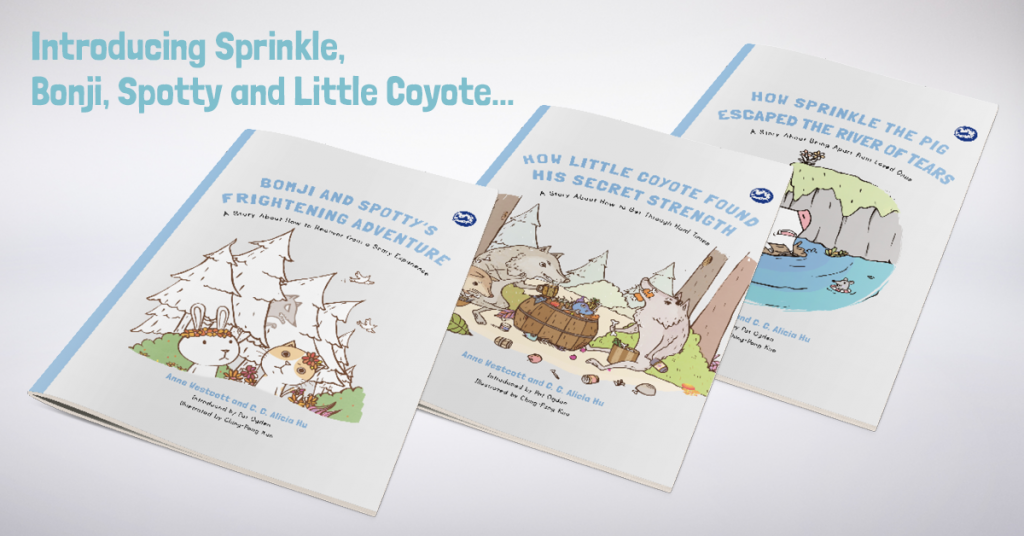 This blog was written by Hidden Strength’s Children’s Series co-author C.C. Alicia Hu. The books are available November 21, 2017 for therapeutic use with children ages 4-10 who have experienced trauma or a frightening situation. Read more about each title and pre-order below:
This blog was written by Hidden Strength’s Children’s Series co-author C.C. Alicia Hu. The books are available November 21, 2017 for therapeutic use with children ages 4-10 who have experienced trauma or a frightening situation. Read more about each title and pre-order below:
How Little Coyote Found His Secret Strength
Bomji and Spotty’s Frightening Adventure
How Sprinkle the Pig Escaped the River of Tears
by C.C. Alicia Hu
Before we can say “no,” our legs kick and set boundaries.
Before we can say “more,” our hands pull and grab for what we need.
Reclaiming our bodies’ hidden strengths empowers all of us.
Nevertheless, in our modern society, we are often disconnected from our bodies. We turn our body-mind into a machine, like a “car” or a “computer,” so we can control or manage our self for performance enhancement. Maybe we “perform” well, yet, we pay a price.
In the field of psychiatry and psychotherapy, for a long time, we labeled many of the body’s innate defense strategies as “symptoms” or “problems” – our capacity to disconnect and dull the pain, a symptom of “dissociation.” Our ability to quiver and shake to discharge the muscle intensity is a sign of weakness or anxiety.
Bring our bodies’ hidden strengths to enhance our resilience
In the Hidden Strengths Therapeutic Storybooks, three intertwined stories and four major animal characters show how our bodies’ possess the hidden strengths to protect our self. In addition, three adult-like characters demonstrate how to provide companionship that won’t overwhelm the major animal characters’ vulnerable nervous system that resulted from traumatic stress.
In each book, after the therapeutic story, there are two sections designed to provide structural prompts for adults to engage in dialogue and exploration with the child. This “expressive phase” is the key to facilitating the child in communicating their own feelings and creating their own stories. What makes our books unique is that we include embodied play activities to help the child process the stories on the basic sensory-motor level.
Using the metaphorical animal characters for teens and adults
These stories are not only therapeutic tools for children ages 4 to 10. These stories can also be used as metaphors to communicate with teens and adults.
Last week, I was presenting part of the story, “Bomji and Spotty’s Frightening Adventure” at a local grassroots, peer-support recovery center. Adult audiences in recovery from mental illness and substance abuse intuitively got the idea that, inside, we are Bomji the Rabbit, who tend to freeze, as well as Spotty the Cat, who tends to fight.
One participant shared that “sit on ready” is an important coping skill in African American culture. The capacity to be vigilant without moving helped her to survive her childhood.
The metaphorical animal characters made it easy for teens and adults to develop compassion toward their inner child. As children, we oftentimes act without thinking like Spotty the Cat. We are still and invisible to avoid danger like Bomji the Rabbit. We cry like Sprinkle the Pig and we overwhelm our caregivers. We submit like Wimpy the Coyote in order to fly under the radar.
Love: self-compassion toward our hidden strengths
From children to teens to adults, one key element in recovery is to cultivate self-compassion. In the Hidden Strengths Therapeutic Storybooks, we hope to help all readers embrace their bodies’ hidden strengths as a way to enhance self-compassion.
Once, I shared a draft of Bomji the Rabbit and Spotty the Cat with a Vietnam veteran who still suffered from the shame of freezing and wanting to run away in a major battle. In reality, he successfully executed his duty; however, he had a hard time forgiving the “weak” part of him. Understanding that motionless defense (e.g., freeze and collapse) is just as natural and valuable as active defense (e.g., fight and flight) brought him a tremendous sense of relief.
Another time, I shared the same story with a teen girl who engaged in self-cutting as a way to cope with inner turbulence. She was able to identify how she also froze when her external environment became too overwhelming and out of control. She was then able to find her own metaphor for her own fearful, vulnerable part without engaging in blaming.
Helping the reader to accept all the different parts of themselves is what we want these books to achieve, through revelation of the development of self-compassion. Before we can accept our angry fighting part as well as our frozen fearful part, it is helpful if we start seeing these natural capacities as our bodies’ hidden strengths. The act of self-compassion includes recognizing the diverse, creative survival strategies in our bodies. Yes, we are fundamentally resilient, even when we are young and small. Our bodies have always possessed these hidden strengths!
For more information, author events, and to follow the Hidden Strengths Series, check out the authors’ Facebook: https://www.facebook.com/AnneWestcottandAliciaHu/